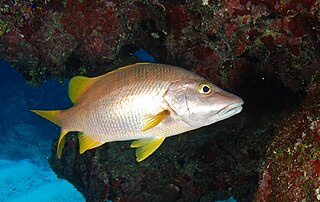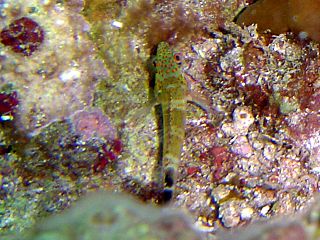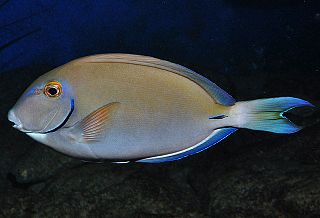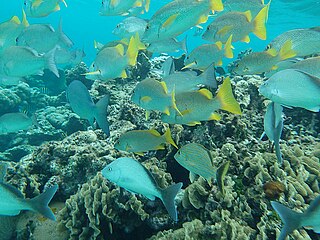
Marine angelfish are perciform fish of the family Pomacanthidae. They are found on shallow reefs in the tropical Atlantic, Indian, and mostly western Pacific Oceans. The family contains seven genera and about 86 species. They should not be confused with the freshwater angelfish, tropical cichlids of the Amazon Basin.

The yellowtail snapper is an abundant species of snapper native to the western Atlantic Ocean including the Gulf of Mexico and the Caribbean Sea. Although they have been found as far north as Massachusetts, their normal range is along Florida south to the West Indies and Brazil. This species is mostly found around coral reefs, but may be found in other habitats. They occur at depths of from near the surface to 180 meters (590 ft), though mostly between 10 and 70 m. This species can reach a length of 86.3 cm (34.0 in), though most do not exceed 40 cm (16 in). The greatest weight recorded for this species is 4.98 kg (11.0 lb). Yellowtail snapper is a commercially important species and has been farmed. It is sought as a game fish by recreational anglers and is a popular species for display in public aquaria. This species is the only known member of its genus.

The schoolmaster snapper, is a species of marine ray-finned fish, a snapper belonging to the family Lutjanidae. It is found in the western Atlantic Ocean. Like other snapper species, it is a popular food fish.

The Caesar grunt, also known as the black grunt, blacktail grunt, or redmouth grunt is a species of marine ray-finned fish, a grunt in the family Haemulidae. It is native to the western Atlantic Ocean

The gray angelfish, also written as grey angelfish and known in Jamaica as the pot cover, is a species of marine ray-finned fish belonging to the marine angelfish family, Pomacanthidae. It is found in the Western Atlantic Ocean.

The doctorfish tang, also known as the doctorfish, is a species of marine ray-finned fish belonging to the family Acanthuridae, the surgeonfishes, unicornfishes and tangs. These fishes are found in the western Atlantic Ocean.

Trachinotus goodei, the palometa, is an ocean-going game fish of the family Carangidae. Other common names include banner pompano, camade fish, cobbler, gafftopsail, great pompano, joefish, longfin pompano, old wife, sand mackerel, streamers jack, wireback. This fish is native to the western Atlantic Ocean from Massachusetts to Bermuda to Argentina. It can be found in the Gulf of Mexico and the Caribbean Sea.

The redspotted hawkfish is a species of marine ray-finned fish, a hawkfish belonging to the family Cirrhitidae. It is found at depths from 2 to 46 m on tropical reefs in the Western Atlantic. The Redspotted Hawkfish is also found in the aquarium trade.

Haemulon vittatum, the boga, is an ocean-going species of grunt native to the western Atlantic Ocean. Bogas are also known as the snit in Jamaica, and bonnetmouth in the Bahamas. It was first described by Cuban zoologist Felipe Poey. This species used to be classified as Inermia vittata, but genetic data revealed that it belongs to the genus Haemulon.

The bluestriped grunt, also known as the boar grunt, golden grunt, humpback grunt, redmouth grunt, or yellow grunt, is a species of marine ray-finned fish, a grunt belonging to the family Haemulidae. It is found in the western Atlantic Ocean.

Acanthemblemaria maria, the secretary blenny, is a species of chaenopsid blenny found in shallow seas in the western central Atlantic Ocean and the Caribbean Sea. It can reach a maximum length of 5 cm (2.0 in) TL.

The yellowface pikeblenny is a species of chaenopsid blenny found in coral reefs in the western central Atlantic, including the Bahamas and Caribbean. It can reach a maximum length of 8.5 centimetres (3.3 in) TL. This species feeds primarily on crustaceans, finfish, and worms and can be found in the commercial aquarium trade. The specific name honours the zoologist, diver and underwater photographer Conrad Limbaugh (1925-1960).
Emblemaria caldwelli, the Caribbean blenny, is a species of chaenopsid blenny found in coral reefs around the Bahamas, Belize, Honduras and Jamaica, in the western central Atlantic ocean. The specific name honours David K. Caldwell, Director of Marineland Research Laboratory, St. Augustine, Florida in gratitude for the loan of specimens.

Haemulon flavolineatum, the French grunt, banana grunt, gold laced grunt, open-mouthed grunt, redmouth grunt, or yellow grunt, is a species of marine ray-finned fish, a grunt belonging to the family Haemulidae. It is native to the western Atlantic Ocean.

Malacoctenus erdmani is a species of labrisomid blenny native to the western Atlantic Ocean and the Caribbean Sea from the Bahamas to Curaçao. This species is an inhabitant of reefs where it prefers areas that provide hiding places such as coral rubble and rock and patches of algae. It can reach a length of 3.8 centimetres (1.5 in) TL. The specific name honours the fishery biologist Donald S. Erdman.

Acanthurus tractus, the five-band surgeonfish, ocean surgeon, or ocean surgeonfish, is a species of ray-finned fish in the family Acanthuridae found in the western Atlantic Ocean, Florida, the Bahamas, the Caribbean Sea and the Gulf of Mexico. Until recently, it was considered a synonym of Acanthurus bahianus, but its status as a separate species was resurrected in 2011.

Elacatinus evelynae, commonly known as the sharknose goby, Caribbean cleaner goby, or Caribbean cleaning goby, is a species of goby native to the Western Atlantic Ocean from the Bahamas and the Lesser Antilles to the northern coast of South America, as well as the Antilles and western Caribbean.

Emmelichthys is a genus of marine ray-finned fishes belonging to the family Emmelichthyidae, the rovers and bonnetmouths. The species in this genus are found in the Atlantic, Indian and Pacific Oceans.

Haemulon album, the white margate, grey grunt, grunt, Margaret fish, Margaret grunt, margate, margate fish, ronco blanco, viuda, white grunt, white pogret, or yellow grunt is a species of ray-finned fish, a large grunt belonging to the family Haemulidae. It is native to the western Atlantic Ocean.
The toadfish goby is a species of bony fish in the family Gobiidae which is found in areas of sandy substrates among coral reefs. It occurs in the western Atlantic Ocean from the Bahamas south through the Caribbean Sea as well as along the Central and South American coast from Belize to Santa Marta, Colombia. It is the only species in the monotypic genus Cryptopsilotris, although it was formerly classified under Psilotris and its generic name means "hidden Pilotris", meaning that it was hidden within that genus.


















